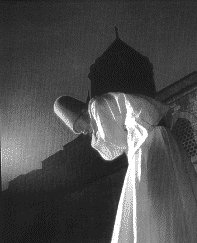 Bismillah ar-Rahman ar-Rahim
Bismillah ar-Rahman ar-Rahim
Whirling Dervishes of Turkey
and The Mevlevi Ensemble
with Kani Karaca
Winter Tour 1997
Sema is the food of the lovers of God,
for within it is the taste of tranquility of mind.
Mevlâna Jalâluddîn Rumi, Mathnawi IV:742
Highlights from Reviews
ALTHOUGH SOME PEOPLE unfamiliar with their history may expect whirling dervishes to offer giddy spinning, this program made clear that these venerable Islamic ceremonies are serene. They are not even theatrical spectacles but sacred rituals… Casting aside their robes, the dervishes were revealed to be wearing white costumes with wide bell-like skirts. They stepped forward, arms crossed in front of their chests. Raising their arms, holding their right palm upward toward heaven and their left palm downward toward earth, they gradually started whirling in a counterclockwise direction. No one rushed, every step looked measured. At times, all the men paused, returning their arms to their chests. Then the whirling began anew, just as unhurried as before. Whirling thereby became a form of contemplation.”
Jack Anderson, New York Times, Monday, February 3, 1997
THE WHIRLING OF DERVISHES… is one method of polishing the human heart, a 700-year old discipline that allows a devotee to experience the immediate… What was striking then about the sema ceremony they performed was its symbolism. The men dropped their black cloaks for the white of an egoless, ecstatic resurrection. Their turning was steady, their bowing gestures humble. The deeply scalloped edges of their white hems, which billowed like flowing surf as they turned counterclockwise, created an image of men floating between this world and an invisible one suffused with divine love… (t)here is something touching about the way the men fall out of formation at a certain note, looking chastened as they cross their arms across their shoulders like children pulled back from a dangerous brink.”
Debra Cash, Boston Globe, Saturday, February 1, 1997
ONLY RARELY do most of us encounter dance as a private act of surrender to the divine. And so the Islamic ceremony of sema… demands a shift in aesthetic sensibility. The seemingly endless rotations of its dancers are intended not for us but for Allah. Twirling 20 to 30 times a minute, with the right hand turned heavenward to receive God’s grace and the left turned down to convey that grace to Earth, the nine dervishes, their eyes half-closed, seemed oblivious… after a time their movements also seemed to melt into one another. The mild tedium of watching the dervishes gradually turned into meditation. Their dance became a prayer, and we were all part of it.”
David O’Reilly, Philadelphia Inquirer, Wednesday, February 5, 1997
SO IS IT a performance, or is it a ceremony? ‘For us, this is real,’ said (Shaikh Kabir) Helminski. Traditionally, a small gallery of spectators has been able to watch the Sema. When introducing the program, Helminski will tell the audience that ‘we consider them guests at the ceremony’… The hope is that ‘people in the audience can share this experience through a kind of resonance. And in fact this happens for a majority of people…’ (T)he dancers are not seeking ecstasy. Instead, they enter a hyperconscious state and attempt to maintain their physical axis (thus the lack of dizziness among the dancers) while contemplating the shaikh sitting in the center of a circle of dancers. The shaikh represents their link to Rumi and their love of God. The dancers consider their turning, which may last a half-hour within a larger performance of music and movement, as a kind of rebalancing of the world by drawing cosmic energies down to Earth.”
Miriam Seidel, Philadelphia Inquirer, Sunday, February 2, 1997
THE SECTIONS OF THE RITUAL focus on the relationships between body and soul, man and God, lover and beloved, with an ideal of submission to God reiterated throughout. This theme and the repetition inherent in the music and dancing take the performance completely outside the realm of conventional entertainment. However, its sense of oneness and yearning for transcendence can speak deeply to any contemporary audience willing to give the event the concentration it deserves.”
Lewis Segal, Los Angeles Times, Monday, January 27, 1997
THE FIRST HALF of the program was devoted to sacred music, performed by musicians of the Turkish-based Mevlevi Ensemble of the Mevlana Culture and Art foundation. The crystalline zither, whispering flutes, soft percussion and low rumbling chants foreshadowed the subtlety and mesmerizing… nature of the dancing to come. The second half of the program was devoted to the sema, or whirling dance. While it may seem odd to bring a religious ceremony, traditionally performed in mosquelike temples, to a performing arts venue, the practice has helped keep the ritual alive… The sema is in effect a meditation in motion. The practitioners, who must train for years before they are permitted to take part, whirl as a reflection of the natural revolutions that move all beings. Through the whirling they seek to achieve a union with God.”
Sarah Kaufman, Washington Post, Tuesday, February 4, 1997

